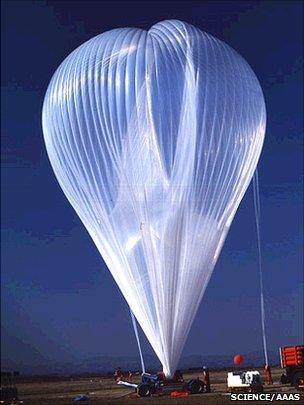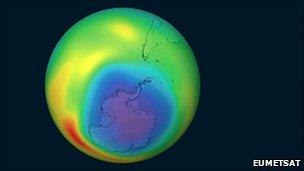Method to trace persistent CFCs
- Published

The French space agency balloons sampled the air up to an altitude of 35km
Ultrafine measurements of atmospheric gases could help track down persistent sources of CFCs thought to be slowing the recovery of the ozone layer.
The use of the refrigerants and aerosol propellants was restricted by a global treaty in 1987, but they have stayed in the air longer than many expected.
A UK-German team has now shown how it is possible to chemically "fingerprint" CFCs to potentially trace their origin.
The group's work is published in the journal Science.
The researchers from the universities of East Anglia and Frankfurt worked on samples of atmosphere retrieved from high in the stratosphere (up to 35km; 115,000ft) by French space agency balloons.
Using mass spectrometers, they were able to detail the ratios of different types (isotopes) of chlorine atoms present in fantastically small concentrations - just 500 parts per trillion - of chlorofluorocarbon-12.
CFC-12 is one of the dominant man-made ozone-eating gases and was widely used in refrigerators, air conditioning systems, fire extinguishers and spray cans before being phased out under the Montreal Protocol.
"This is the first time we've been able to measure the isotopes in gases in such small concentrations in the atmosphere, and also one of the first applications for chlorine isotope ratios in the atmosphere," Dr Jan Kaiser, from UEA's School of Environmental Sciences, told BBC News.
Atomic clues
The new research shows that the higher you go in the atmosphere, the more of a heavier chlorine atom (chlorine-37) is present in any sample of CFC-12.
"CFCs are eventually broken down by light in a process called photolysis, and the CFCs with the lighter isotopes (chlorine-35) break down faster," explained UEA colleague Dr Johannes Laube.
"This is an effect that has been observed for other gases, such as nitrous oxide."

The ozone layer above Antarctica thins (blue) markedly in the austral spring
The sharp falls in global emissions of CFCs seen in the early years following the Montreal Protocol have levelled off, and it is clear that some chlorofluorocarbons, which should have been exhausted in developed countries by now, are still in use.
The ability to make fine measurements of the type reported in Science opens the door to chemical fingerprinting - of being able to tie a particular sample to a known origin.
It is established that different manufacturing techniques will produce gases with particular isotopic ratios. Such information could help the authorities identify continuing sources.
"Even though the production and use of CFC-12 is forbidden by the Montreal Protocol, we still find it in the atmosphere," said Dr Kaiser.
"We find fresh plumes when we go on aircraft campaigns in the lower atmosphere, the troposphere. This indicates it's either still being produced or is being stockpiled."
Cycle of decline
These troublesome sources might be emissions from old landfill sites recognised to hold waste containing CFCs, or from cities in those countries where there is a black-market in chlorofluorocarbons. This market, for example, might be supplying cars with ageing air conditioning systems needing replenishment.
Ozone is a molecule that is composed of three oxygen atoms. It is responsible for filtering out harmful ultra-violet radiation from the Sun.
The gas is constantly being made and destroyed in the stratosphere. In an unpolluted atmosphere, this cycle of production and decomposition is in equilibrium.
But when the chlorine atoms released from CFCs enter this process they act as catalysts favourable to the destruction of ozone.
This enhanced decomposition is most evident in a deep thinning of the ozone layer above Antarctica in the austral spring.